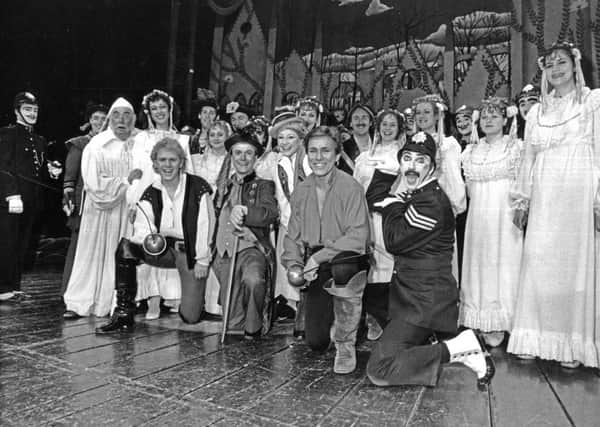Nostalgia on Tuesday: Theatre of panto


Sheffield’s Lyceum Theatre in Norfolk Street was for much of the 20th century well known for putting on spectacular pantomimes. In later years the building was saved from demolition and now continues to celebrate its Christmas pantomime tradition.
A history of the Norfolk Street site reveals a wooden structure was erected there in 1879 and for a number of years was used as a circus. A new building was built becoming known as the City Theatre. The foundation stone was laid on July 28, 1893, in the presence of Sir Augustus Harris, an actor, impresario and dramatist and often nicknamed the ‘Father of Modern Pantomime’. Capable of accommodating 2,500 people.
Advertisement
Hide AdAdvertisement
Hide AdLavishly decorated by Messrs De Jong & Co, of London, the City Theatre opened on Boxing Day 1893 with a production of Royal Divorce. The theatre lasted only four years before being closed and rebuilt to become the Lyceum Theatre. The contract, worth nearly £11,000, was placed in May 1897 with Longden & Son, of Neepsend. The great Victorian theatre architect WGR Sprague was responsible for the designs.
On October 11, 1897, the Carl Rosa Grand Opera company had the honour of formally opening the new Lyceum Theatre at the Tudor Street/Arundel Street junction. One newspaper report stated the Lyceum offered a far greater inducement to the production of first class opera and dramas “for, not only is the stage and all its accessories complete in every detail essential in well played productions, but the auditorium is so attractively comfortable”.
The architecture of the frontage was a bold classic design, relieved at intervals by groups of flowers and foliage. A circular tower, rising to a height of 70ft, and surmounted by a copper dome, was crowned by a flying figure, supporting an arc lamp.
The theatre was intended to hold 3,000 people and no columns were used ensuring a good view from every seat. There were eight private boxes. Initially the Lyceum was the property of the Lyceum Theatre (Sheffield) Ltd and under the direction of John Hart who also had theatrical interests in Yorkshire at the Grand Theatre, Leeds; Theatre Royal and Opera House, Bradford; and Grand Theatre, Hull.
Advertisement
Hide AdAdvertisement
Hide AdOn November 6, 1899, fire broke out at the Lyceum and completely wrecked parts of the building. Fortunately, nobody was injured, but the owners suffered a heavy loss. Members of a large travelling theatrical company were robbed of all their belongings and the large permanent staff was laid off.
In spite of this calamity, the Lyceum intended to open at Christmas 1899 to stage Twinkle Little Star even though scenery had been destroyed in the fire.
During the 20th century, the Lyceum quickly became known as one of the country’s leading theatres. Sir Henry Irving, the greatest of all the Victorian actor/managers, brought his company to the city with the legendary Ellen Terry as his leading lady. The great French actress Sarah Bernhardt brought her greatest role, La Dame Aux Camelias, to the city in 1904.
Many of the major music hall stars of the day trod the Lyceum boards besides other regular visitors who included the D’Oyly Carte Opera, Sadlers’ Wells Opera and the Royal Ballet.
Advertisement
Hide AdAdvertisement
Hide AdThe Lyceum promoted itself as being the ‘Home of Sheffield’s Pantomime’. For many years, the months between Christmas Eve and Easter were happy pantomime festival seasons with visiting producers bringing famous actors and variety turns to entertain local families twice a day. In later years, the Lyceum was attracting stars such as Morecambe and Wise, Harry Secombe and Frankie Howerd.
With millions switching to television during the 1960s the Lyceum’s popularity waned. Installing cine equipment was considered impractical and in 1966 bingo was introduced during the summer months with live theatre returning later in the year.
The curtain fell for what seemed the final time in 1969, when singer Vince Hill, starred as Dick Wittington in the last of the Lyceum’s famous pantomimes .
Then, sadly, came years of neglect, when the building became an abandoned ruin, filled only with the ghosts of past stage triumphs and haunted by the threat of demolition.
Advertisement
Hide AdAdvertisement
Hide AdA Save the Lyceum campaign, formed in 1969, failed to see any action and, apart from a brief spell as a rock venue between June to October 1981, all other plans for the theatre’s future were unsuccessful. Probably the only factor which saved it from demolition was being awarded Grade II listed building status earlier in March 1972.
In the late 1980s, a new Lyceum Trust, formed between David Heugh, Norman White, the Crucible and the city council, received news that the theatre had won grants to undergo an extensive restoration programme which eventually topped a staggering £12m.
The restoration work was not easy. The need for greatly improved facilities meant that a large part of the building had to be ripped down while making sure that the listed building retained its original character.
A setback occurred in September 1990 when an electrical fault caused a blaze in the upper balcony, wrecking newly installed carpets and fittings. But, the Lyceum still managed to open on schedule in a blaze of publicity, on December 10, 1990. It was a theatre dream which many thought would never come true.